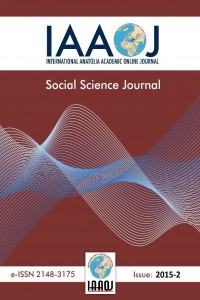Öz
Bu çalışma, finansal gelişme ile gelir eşitsizliği arasındaki ilişkiyi araştırma amacı taşır. Ayrıca,
ekonomik büyüme ve ticari dışa açıklığı gelir eşitsizliğinin potansiyel belirleyicileri olarak ampirik modele dahil
eder. ARDL sınır testi eşbütünleşme yaklaşımı kullanılarak değişkenler arasında bir uzun dönem ilişkisi
bulunmuştur. Aynı zamanda finansal gelişme ile gelir eşitsizliği arasında negatif bir ilişki tespit edilmiştir. Bu,
finansal gelişmenin söz konusu dönemde gelir eşitsizliğini azalttığı anlamına gelir. Sonuçlar, vektör hata
düzeltme modeli (VHDM) yaklaşımı vasıtasıyla finansal gelişmeden gelir eşitsizliğine doğru işleyen bir uzun
dönem Granger nedenselliğini göstermektedir. Sonuçlar, Türkiye ekonomisi için bazı politika çıkarımları
sunabilmektedir.
Anahtar Kelimeler
Finansal gelişme Gelir eşitsizliği ARDL sınır testi VHDM nedenselliği Türkiye
Kaynakça
- ANG, J.B. (2008). Finance and Inequality: The Case of India, Monash University, Department of Economics, Discussion Paper No. 8, 1-25.
- BALIGH, N. and PIRAEE, K. (2013). Financial Development and Income Inequality Relationship in Iran, Middle-East Journal of Scientific Research, 13, 56-64.
- BECK, T., DEMIRGUC-KUNT, A. and LEVINE, R. (2007). Finance, Poverty and Income Inequality: Cross-country Evidence, NBER Working Paper Series No. 10979.
- BHARGAVA, A. (1986). On the Theory of Testing for Unit Roots in Observed Time Series, Review of Economics Studies, 53(3), 369-384.
- CLARKE, G., XU, L.C. and ZHOU, H-F. (2006). Finance and Income Inequality: What do the Data Tell Us?, Southern Economic Journal, 72(3), 578-596.
- ELLIOT, G., ROTHENBERG, T.J. and STOCK, J.H. (1996). Efficient Tests for an Autoregressive Unit Root, Econometrica, 64, 813-836.
- GIMET, C. and LAGOARDE-SEGOT, T. (2011). A Closer Look at Financial Development and Income Distribution, GATE Working Paper No. 1104.
- GURLEY, J. G. and SHAW, E.S. (1955). Financial Aspects of Economic Development, American Economic Review, 45, 515-538.
- JALIL, A. and FERİDUN, M. (2011). Long-run Relationship between Income Inequality and Financial Development in China, Journal of the Asia Pacific Economy, 16(2), 202-214.
- KAPPEL, V. (2010). The Effects of Financial Development on Income Inequality and Poverty, Working Paper No. 10/127, Center of Economic Researchat ETH Zurich.
- KIM, D-H. and LIN, S-C. (2011). Nonlinearity in the Financial Development and Income Inequality Nexus, Journal of Comparative Economics, 39, 310-325.
- LAW, S.H. and TAN, H.B. (2009). The Role of Financial Development on Income Inequality in Malaysia, Journal of Economic Development, 34(2), 153-168.
- LEVINE, R. (2004). Finance and Growth: Theory and Evidence, NBER Working Paper No. 10766.
- MCKINNON, R. I. (1973). Money and Capital in Economic Development, Washington, DC: Brookings Institution.
- MERTON, R. C. (1992). Financial Innovation and Economic Performance, Journal of Applied Corporate Finance, 4, 12-22.
- MOOKERJEE, R. and KALIPIONI, P. (2010). Availability of Financial Services and Income Inequality: The Evidence from Many Countries, Emerging Markets Review, 11, 404-408.
- NG, S. and PERRON, P. (2001). Lag Length Selection and the Construction of Unit Root Tests with Good Size and Power, Econometrica, 69(6), 1519-1554.
- NIKOLOSKI, Z. (2013). Financial Sector Development and Inequality: Is there a Financial Kuznets Curve?, Journal of International Development, 25, 897-911.
- PERRON, P. (1988). Regression Theory for Near-Integrated Time Series, Journal of Econometrics, 56(5), 1021-1043.
- PESARAN, M.H., SHIN, Y. and SMITH, R. (2001). Bounds Testing Approaches to the Analysis of Level Relationships, Journal of Applied Economics, 16, 289-326.
- SEBASTIAN, J. and SEBASTIAN, W. (2011). Financial Development and Income Inequality, CESIFO Working Paper: Fiscal Policy, Macroeconomics and Growth, No. 3687.
- SHAHBAZ, M. and ISLAM, F. (2011). Financial Development and Income Inequality in Pakistan: An Application of ARDL Approach, Journal of Economic Development, 36, 35-58.
- SHAHBAZ, M., TIWARI, A. and REZA, S.J. (2012). Financial Development and Income Inequality: Is there any Financial Kuznets curve in Iran?, MPRA Paper No. 40899.
- SHAHBAZ, M., LODHI, A. and BUTT, M.S. (2007). Financial Development under the Shade of Globalization and Financial Institutions: The Case of Pakistan, Philippine Review of Economics, 44(2), 125-148.
- TAN, H-B. and LAW, S-K. (2012). Nonlinear Dynamics of the Finance-Inequality nexus in Developing Countries, Journal of Economic Inequality, 9, 1-13.
- TIWARI, A.K., SHAHBAZ, M. and ISLAM, F. (2013). Does Financial Development Increase Rural-urban Income Inequality? Cointegration Analysis in the Case of Indian Economy, International Journal of Social Economics, 40(2), 151-168.
- UR-REHMAN, H., KHAN, S. and AHMED, I. (2008). Income Distribution, Growth and Financial Development: A Cross Country Analysis, Pakistan Economic and Social Review, 46(1), 1- 16.
Öz
This study aims at examining the relationship between financial development and income inequality in
case of Turkey. In addition, this study incorporates economic growth and trade openness to the empirical model
as potantial determinants of income inequality. Using ARDL bounds testing approach to cointegration, we find a
long run relationship between the variables. We also find a negative relationsip between financial development
and income inequality in the long run implying that financial devolopment decreases income inequality over the
period. The results show that there exists a long run Granger causality running from financial development to
income inequality by applying the VECM approach. The results can present important policy implications for
Turkish economy.
Anahtar Kelimeler
Income inequality financial development ARDL bounds test VECM causality Turkey
Kaynakça
- ANG, J.B. (2008). Finance and Inequality: The Case of India, Monash University, Department of Economics, Discussion Paper No. 8, 1-25.
- BALIGH, N. and PIRAEE, K. (2013). Financial Development and Income Inequality Relationship in Iran, Middle-East Journal of Scientific Research, 13, 56-64.
- BECK, T., DEMIRGUC-KUNT, A. and LEVINE, R. (2007). Finance, Poverty and Income Inequality: Cross-country Evidence, NBER Working Paper Series No. 10979.
- BHARGAVA, A. (1986). On the Theory of Testing for Unit Roots in Observed Time Series, Review of Economics Studies, 53(3), 369-384.
- CLARKE, G., XU, L.C. and ZHOU, H-F. (2006). Finance and Income Inequality: What do the Data Tell Us?, Southern Economic Journal, 72(3), 578-596.
- ELLIOT, G., ROTHENBERG, T.J. and STOCK, J.H. (1996). Efficient Tests for an Autoregressive Unit Root, Econometrica, 64, 813-836.
- GIMET, C. and LAGOARDE-SEGOT, T. (2011). A Closer Look at Financial Development and Income Distribution, GATE Working Paper No. 1104.
- GURLEY, J. G. and SHAW, E.S. (1955). Financial Aspects of Economic Development, American Economic Review, 45, 515-538.
- JALIL, A. and FERİDUN, M. (2011). Long-run Relationship between Income Inequality and Financial Development in China, Journal of the Asia Pacific Economy, 16(2), 202-214.
- KAPPEL, V. (2010). The Effects of Financial Development on Income Inequality and Poverty, Working Paper No. 10/127, Center of Economic Researchat ETH Zurich.
- KIM, D-H. and LIN, S-C. (2011). Nonlinearity in the Financial Development and Income Inequality Nexus, Journal of Comparative Economics, 39, 310-325.
- LAW, S.H. and TAN, H.B. (2009). The Role of Financial Development on Income Inequality in Malaysia, Journal of Economic Development, 34(2), 153-168.
- LEVINE, R. (2004). Finance and Growth: Theory and Evidence, NBER Working Paper No. 10766.
- MCKINNON, R. I. (1973). Money and Capital in Economic Development, Washington, DC: Brookings Institution.
- MERTON, R. C. (1992). Financial Innovation and Economic Performance, Journal of Applied Corporate Finance, 4, 12-22.
- MOOKERJEE, R. and KALIPIONI, P. (2010). Availability of Financial Services and Income Inequality: The Evidence from Many Countries, Emerging Markets Review, 11, 404-408.
- NG, S. and PERRON, P. (2001). Lag Length Selection and the Construction of Unit Root Tests with Good Size and Power, Econometrica, 69(6), 1519-1554.
- NIKOLOSKI, Z. (2013). Financial Sector Development and Inequality: Is there a Financial Kuznets Curve?, Journal of International Development, 25, 897-911.
- PERRON, P. (1988). Regression Theory for Near-Integrated Time Series, Journal of Econometrics, 56(5), 1021-1043.
- PESARAN, M.H., SHIN, Y. and SMITH, R. (2001). Bounds Testing Approaches to the Analysis of Level Relationships, Journal of Applied Economics, 16, 289-326.
- SEBASTIAN, J. and SEBASTIAN, W. (2011). Financial Development and Income Inequality, CESIFO Working Paper: Fiscal Policy, Macroeconomics and Growth, No. 3687.
- SHAHBAZ, M. and ISLAM, F. (2011). Financial Development and Income Inequality in Pakistan: An Application of ARDL Approach, Journal of Economic Development, 36, 35-58.
- SHAHBAZ, M., TIWARI, A. and REZA, S.J. (2012). Financial Development and Income Inequality: Is there any Financial Kuznets curve in Iran?, MPRA Paper No. 40899.
- SHAHBAZ, M., LODHI, A. and BUTT, M.S. (2007). Financial Development under the Shade of Globalization and Financial Institutions: The Case of Pakistan, Philippine Review of Economics, 44(2), 125-148.
- TAN, H-B. and LAW, S-K. (2012). Nonlinear Dynamics of the Finance-Inequality nexus in Developing Countries, Journal of Economic Inequality, 9, 1-13.
- TIWARI, A.K., SHAHBAZ, M. and ISLAM, F. (2013). Does Financial Development Increase Rural-urban Income Inequality? Cointegration Analysis in the Case of Indian Economy, International Journal of Social Economics, 40(2), 151-168.
- UR-REHMAN, H., KHAN, S. and AHMED, I. (2008). Income Distribution, Growth and Financial Development: A Cross Country Analysis, Pakistan Economic and Social Review, 46(1), 1- 16.
Ayrıntılar
| Birincil Dil | Türkçe |
|---|---|
| Bölüm | Makaleler |
| Yazarlar | |
| Yayımlanma Tarihi | 7 Haziran 2016 |
| Yayımlandığı Sayı | Yıl 2015 Cilt: 3 Sayı: 2 |
Dergimizin Tarandığı İndeksler









International Anatolia Academic Online Journal / Sosyal Bilimler Dergisi
e-ISSN 2148-3175


